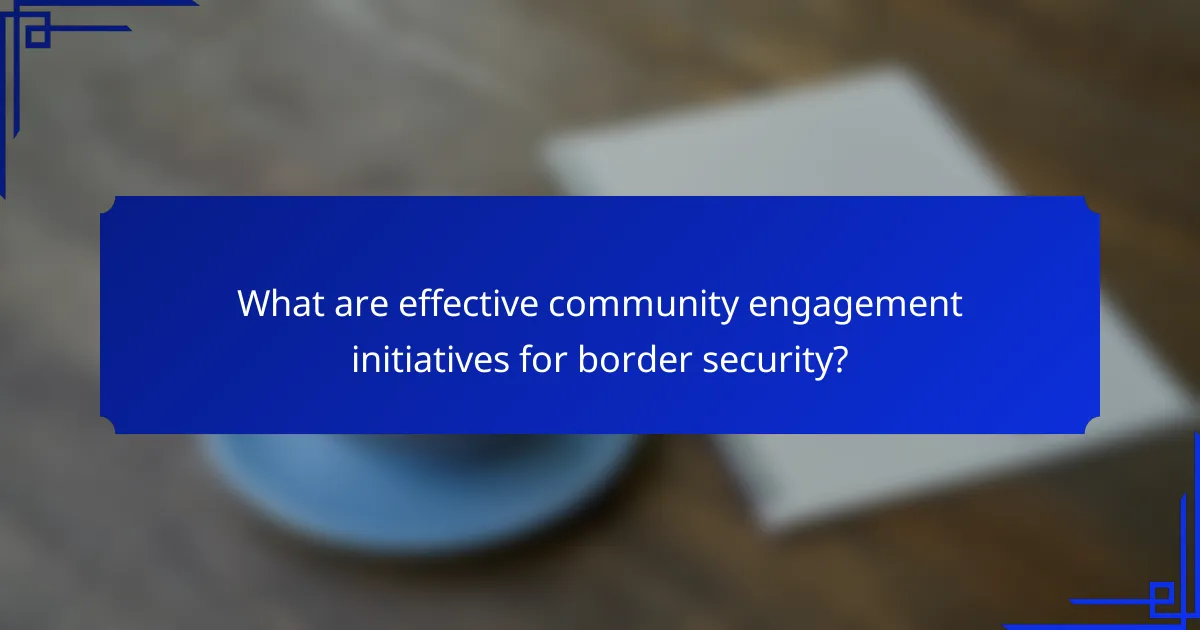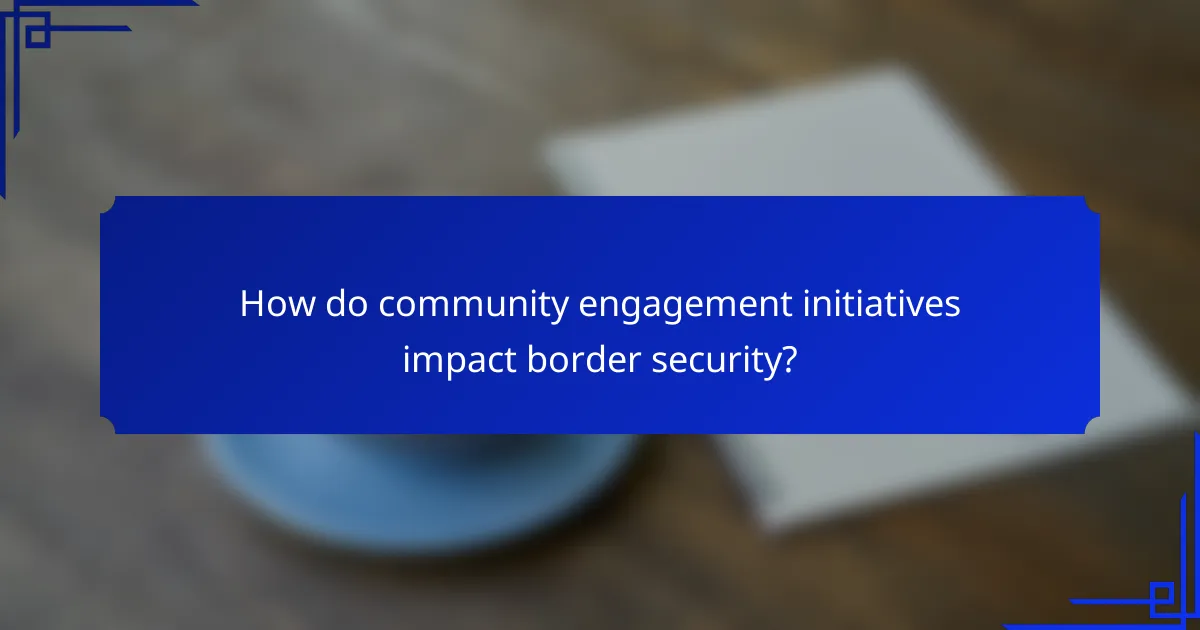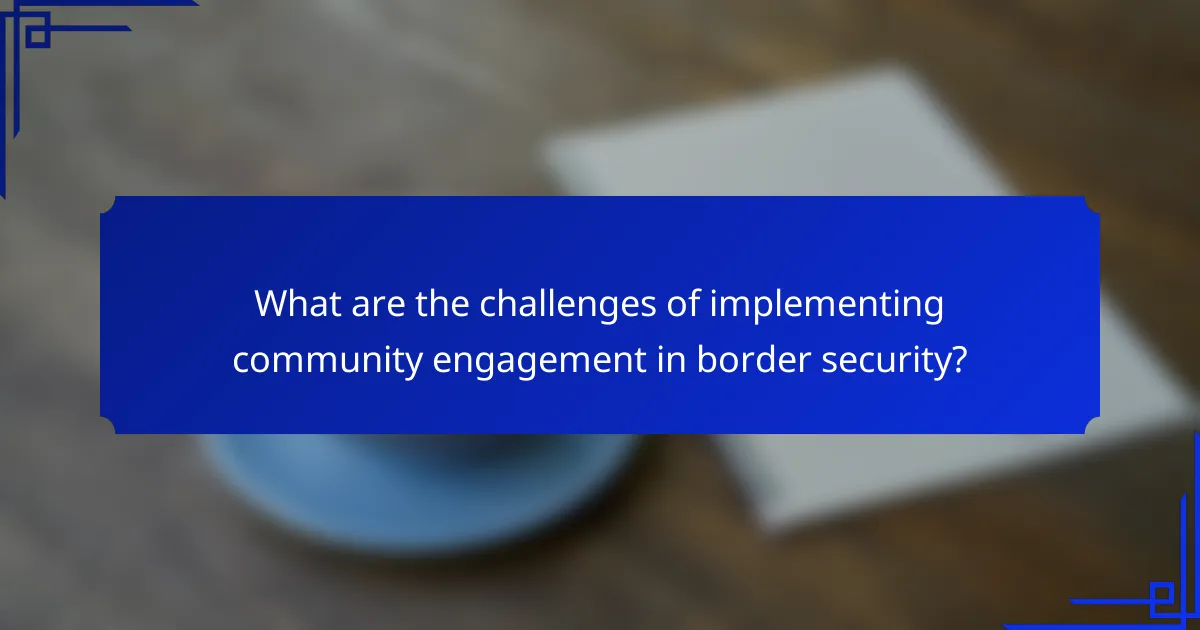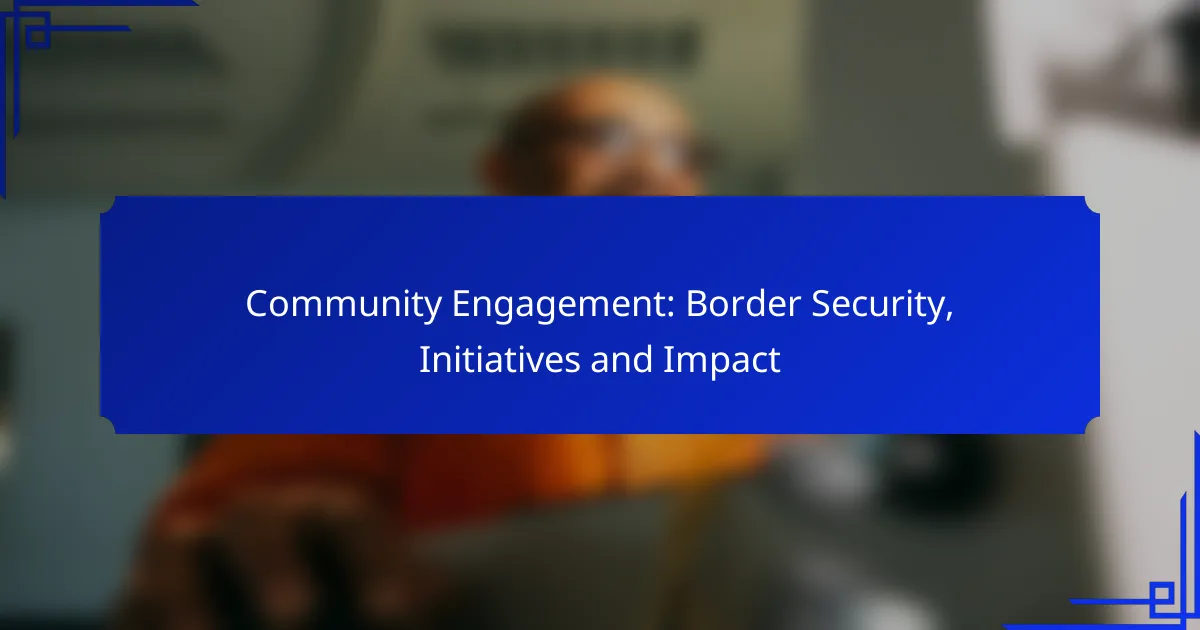Community engagement initiatives play a crucial role in enhancing border security by fostering collaboration between local residents and law enforcement. These efforts not only improve communication and build trust but also empower communities to actively participate in addressing security challenges, ultimately creating a safer environment for all. However, successful implementation can be hindered by challenges such as inadequate funding and reluctance from community members to engage.

What are effective community engagement initiatives for border security?
Effective community engagement initiatives for border security involve collaborative efforts between local residents, law enforcement, and organizations to enhance safety and awareness. These initiatives foster trust, improve communication, and empower communities to actively participate in border security efforts.
Neighborhood watch programs
Neighborhood watch programs encourage residents to observe and report suspicious activities in their areas. These programs typically involve regular meetings, training sessions, and the establishment of communication channels among neighbors and local law enforcement. By fostering vigilance and cooperation, these initiatives can significantly deter crime and enhance community safety.
To implement a neighborhood watch, start by gathering interested residents and contacting local law enforcement for support. Establish clear guidelines for reporting suspicious behavior and organize regular meetings to discuss concerns and share updates.
Community forums and workshops
Community forums and workshops provide platforms for residents to engage directly with law enforcement and border security officials. These events facilitate open dialogue, allowing community members to voice concerns, ask questions, and learn about security measures in place. They can also serve as educational sessions on topics like crime prevention and emergency preparedness.
To maximize participation, schedule these forums at convenient times and promote them through local channels. Consider incorporating interactive elements, such as Q&A sessions or breakout discussions, to encourage active involvement from attendees.
Partnerships with local organizations
Forming partnerships with local organizations, such as schools, businesses, and non-profits, can enhance border security initiatives. These collaborations can leverage resources, expertise, and networks to address community-specific security challenges more effectively. For example, schools can host safety workshops, while businesses can support outreach campaigns.
Identify key organizations in your area and propose collaborative projects that align with mutual goals. Regularly assess the impact of these partnerships to ensure they are meeting community needs and adjust strategies as necessary.
Social media outreach campaigns
Social media outreach campaigns can effectively disseminate information about border security initiatives and engage the community. Platforms like Facebook, Twitter, and Instagram allow for real-time updates, alerts about suspicious activities, and sharing of safety tips. These campaigns can also foster a sense of community by encouraging residents to share their experiences and concerns.
To create an effective campaign, develop a content calendar that includes regular posts, safety tips, and community highlights. Engage with followers by responding to comments and encouraging them to share the information within their networks.
Volunteer patrols
Volunteer patrols involve community members actively participating in monitoring their neighborhoods to enhance security. These patrols can be organized through local groups and typically operate in coordination with law enforcement. Volunteers can help deter crime by being a visible presence and reporting any suspicious activities.
When establishing a volunteer patrol, ensure participants receive proper training and understand their roles and responsibilities. Set clear boundaries regarding their authority and emphasize the importance of communication with law enforcement to ensure safety and effectiveness.

How do community engagement initiatives impact border security?
Community engagement initiatives significantly enhance border security by fostering collaboration between local residents and law enforcement. These programs facilitate the exchange of information, build trust, and raise awareness about security challenges, ultimately leading to a safer environment.
Improved information sharing
Effective community engagement initiatives promote better information sharing between residents and border security agencies. When communities feel empowered to report suspicious activities, law enforcement can respond more swiftly and accurately. This collaboration often leads to the identification of potential threats before they escalate.
For instance, neighborhood watch programs can serve as a platform for residents to communicate directly with local authorities, ensuring that critical information flows seamlessly. Regular community meetings can also enhance this exchange, allowing for real-time updates on security concerns.
Enhanced trust between communities and law enforcement
Building trust between communities and law enforcement is crucial for effective border security. When residents see law enforcement as allies rather than adversaries, they are more likely to cooperate and share vital information. This trust can be cultivated through transparency, consistent communication, and community involvement in security initiatives.
Programs that involve law enforcement in community events, such as safety fairs or educational workshops, can strengthen these relationships. By engaging with residents in non-enforcement contexts, officers can humanize their roles and foster a sense of partnership.
Increased public awareness of security issues
Community engagement initiatives play a vital role in raising public awareness about security issues related to border safety. Through educational campaigns and outreach programs, residents become informed about the risks and challenges facing their communities. This knowledge empowers them to take proactive measures to enhance their safety.
For example, workshops on recognizing human trafficking signs or drug smuggling tactics can equip community members with the tools they need to identify and report suspicious activities. Increased awareness leads to a more vigilant population, which is essential for effective border security.
Reduction in crime rates
Community engagement initiatives can contribute to a reduction in crime rates, particularly in areas near borders. When residents are actively involved in security efforts, they are more likely to report crimes and suspicious behavior, leading to quicker law enforcement responses. This proactive approach can deter criminal activities.
Research has shown that neighborhoods with strong community ties and active engagement often experience lower crime rates. Programs that encourage community participation in policing efforts, such as citizen patrols, can further enhance this effect by creating a visible deterrent to potential offenders.

What are the challenges of implementing community engagement in border security?
Implementing community engagement in border security faces several challenges that can hinder effective collaboration. Key issues include inadequate funding, community reluctance to participate, and miscommunication among stakeholders.
Lack of funding and resources
A significant challenge in community engagement for border security is the lack of funding and resources. Limited budgets can restrict outreach programs, training, and the necessary tools to facilitate effective communication between authorities and the community.
For instance, without adequate financial support, initiatives may struggle to provide workshops or informational sessions that educate the public about border security measures. This can lead to a lack of awareness and understanding, further complicating community involvement.
Community resistance to participation
Community resistance to participation can stem from distrust or previous negative experiences with authorities. Residents may feel that their input is undervalued or that engagement efforts are merely superficial.
To overcome this resistance, it is crucial to build genuine relationships with community members. Engaging local leaders and demonstrating the tangible benefits of participation can help foster a more cooperative environment.
Miscommunication between stakeholders
Miscommunication between stakeholders often leads to misunderstandings and ineffective engagement strategies. Different parties may have varying objectives or interpretations of border security, which can create friction.
Establishing clear communication channels and regular meetings can help align goals and expectations. Utilizing straightforward language and avoiding jargon can also enhance understanding among all parties involved.

How can communities measure the effectiveness of engagement initiatives?
Communities can measure the effectiveness of engagement initiatives through various methods that provide insights into participation, satisfaction, and impact. Key approaches include collecting feedback, analyzing crime statistics, and monitoring participation rates in programs.
Surveys and feedback forms
Surveys and feedback forms are essential tools for gathering direct input from community members about their experiences with engagement initiatives. These instruments can include questions about satisfaction, perceived safety, and suggestions for improvement.
To maximize effectiveness, surveys should be concise and distributed through multiple channels, such as online platforms and community events. Aim for a response rate of at least 20-30% to ensure the data is representative.
Crime statistics analysis
Analyzing crime statistics provides a quantitative measure of the impact of community engagement initiatives on local safety. By comparing crime rates before and after the implementation of specific programs, communities can assess whether these initiatives contribute to reducing crime.
It is important to consider external factors that may influence crime rates, such as economic conditions or law enforcement changes. Utilize local law enforcement data and community reports to gain a comprehensive understanding.
Participation rates in programs
Monitoring participation rates in community programs is a straightforward way to gauge engagement effectiveness. High participation rates often indicate that initiatives resonate with community members and meet their needs.
Communities should track attendance at events, enrollment in programs, and volunteer involvement. Setting benchmarks based on past participation can help identify trends and areas for improvement, aiming for a consistent increase in engagement over time.

What role do local governments play in community engagement for border security?
Local governments are crucial in fostering community engagement for border security by facilitating communication between residents and authorities. They implement initiatives that promote public awareness and participation in security measures, ensuring that community concerns are addressed effectively.
Funding and resource allocation
Local governments play a significant role in funding and resource allocation for border security initiatives. They often allocate budgets to support community programs, training for law enforcement, and public awareness campaigns. This funding can come from local taxes, state grants, or federal assistance programs.
Effective resource allocation involves prioritizing areas with higher security needs. For example, municipalities may focus on enhancing surveillance in regions with frequent border crossings or investing in community outreach programs to educate residents about security protocols.
Policy development and support
Local governments are instrumental in developing and supporting policies that enhance border security through community engagement. They collaborate with federal and state agencies to create regulations that reflect local needs and concerns. This collaboration helps ensure that policies are practical and effective.
Additionally, local governments can facilitate public forums to gather community input on security policies. By involving residents in the policy-making process, they can foster a sense of ownership and responsibility, which is vital for the success of border security initiatives.
